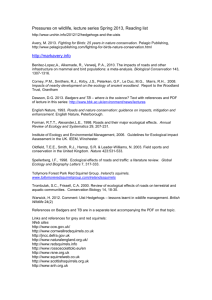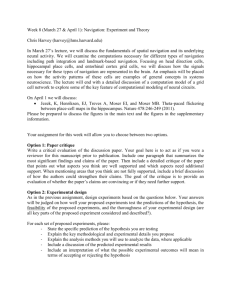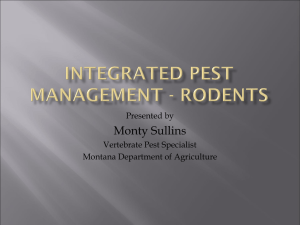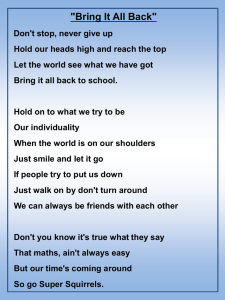SUPPLEMENTARY FEEDING
advertisement
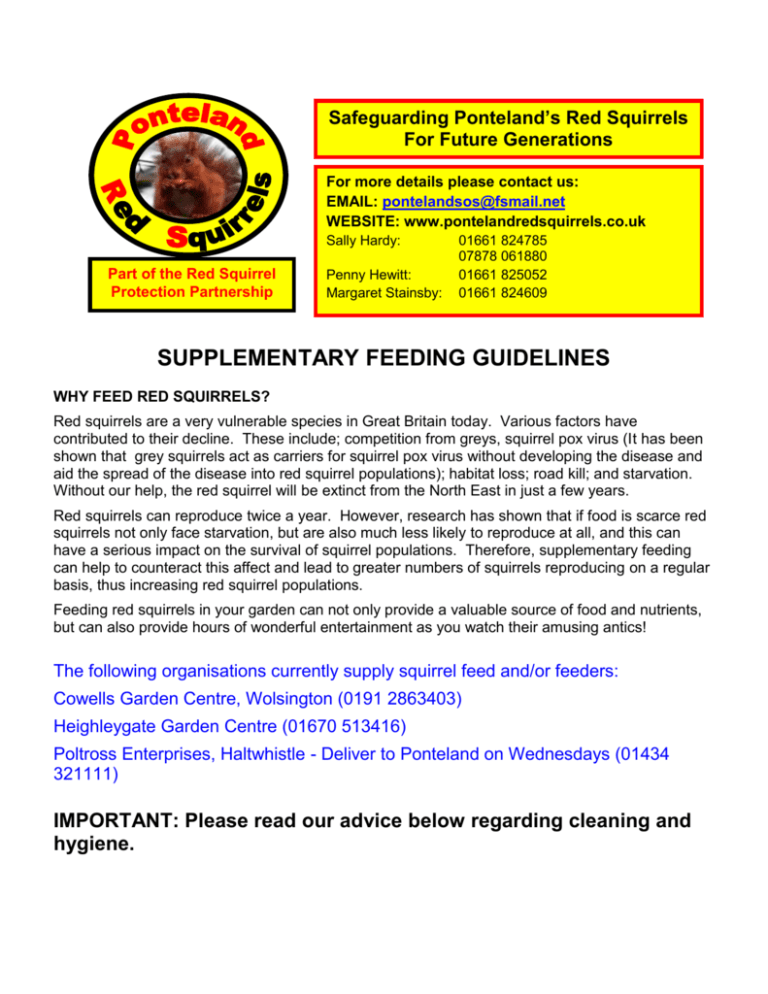
Safeguarding Ponteland’s Red Squirrels For Future Generations For more details please contact us: EMAIL: pontelandsos@fsmail.net WEBSITE: www.pontelandredsquirrels.co.uk Sally Hardy: Part of the Red Squirrel Protection Partnership Penny Hewitt: Margaret Stainsby: 01661 824785 07878 061880 01661 825052 01661 824609 SUPPLEMENTARY FEEDING GUIDELINES WHY FEED RED SQUIRRELS? Red squirrels are a very vulnerable species in Great Britain today. Various factors have contributed to their decline. These include; competition from greys, squirrel pox virus (It has been shown that grey squirrels act as carriers for squirrel pox virus without developing the disease and aid the spread of the disease into red squirrel populations); habitat loss; road kill; and starvation. Without our help, the red squirrel will be extinct from the North East in just a few years. Red squirrels can reproduce twice a year. However, research has shown that if food is scarce red squirrels not only face starvation, but are also much less likely to reproduce at all, and this can have a serious impact on the survival of squirrel populations. Therefore, supplementary feeding can help to counteract this affect and lead to greater numbers of squirrels reproducing on a regular basis, thus increasing red squirrel populations. Feeding red squirrels in your garden can not only provide a valuable source of food and nutrients, but can also provide hours of wonderful entertainment as you watch their amusing antics! The following organisations currently supply squirrel feed and/or feeders: Cowells Garden Centre, Wolsington (0191 2863403) Heighleygate Garden Centre (01670 513416) Poltross Enterprises, Haltwhistle - Deliver to Ponteland on Wednesdays (01434 321111) IMPORTANT: Please read our advice below regarding cleaning and hygiene. The following information has been compiled by Ponteland Red Squirrels using information from Red Alert. WHY DO RED SQUIRRELS COME TO YOUR GARDEN? Although squirrels come to your garden to look for materials such as moss for nest lining, or to drink from you garden pond, the biggest attraction is food. WHAT SHOULD YOU PROVIDE? It is best to feed a variety of different foods, similar to those that the squirrel might forage for in the wild. In fact, the red squirrel will pillage the nuts and seeds found naturally in your garden. The most suitable foods for red squirrels are hazelnuts, sunflower seeds, beech (cob) nuts and pine nuts. Sweet chestnuts and walnuts are also suitable. Unsalted peanuts are a favourite too, but should be not be given in isolation. Some squirrels also like oats! Please note that red squirrels don’t like maize (sweet corn)! Young red squirrels can suffer from calcium deficiency if they feed too often on the wrong sort of food. Therefore, peanuts should not be given exclusively, but as part of a varied diet. If available, an additional calcium source could be provided with your squirrel food. This is particularly valuable during the summer for juvenile and female squirrels. To reduce calcium deficiency provide: pieces of apple or carrot; a supplement added to the feed or a dish of drinking water; bone meal added to the dry feed mix; a cuttlefish bone or antler placed near the feeder. IF YOU DO FEED, PLEASE MAKE SURE THAT: THE FEEDER AND FOOD ARE KEPT AS CLEAN AS POSSIBLE TO PREVENT THE SPREAD OF DISEASE, PARTICULARLY THE SQUIRREL POX VIRUS. Feeders should be regularly cleaned (preferably every week) with a disinfectant/water (1:10) solution such as Citrox or Ark-klens (these are safe for animals and available from most animal feed stores and some garden centres, such as Cowells). You avoid sweet, dried foods such as raisons and sultanas, as these are hard to digest and can cause calcium deficiency. You make sure that food isn't scattered on the ground but is placed as high as possible - a good feeder location is against a tree or wall so that the squirrel doesn't have to cross open ground. Cats account for a high number of fatalities in gardens visited by squirrels. Provide a source of water if it is not naturally available. HOW OFTEN SHOULD YOU FEED SQUIRRELS? Regular feeding every few days is best rather than having food permanently available, as this will encourage the squirrels to forage for natural food too. This way, you are providing a supplementary food source rather than the only source of food and you will not encourage them into bad habits. However, please top up your feeders more regularly during the summer months when natural food is scarce. FEEDING THROUGH THE SEASON Feed your red squirrels throughout the year. In the wild, red squirrels feed on shoots and flowers in spring, and nuts and fruits in autumn and winter. The critical period to feed reds is during the summer months before the fruits and nuts are ripe, when their natural food is in short supply. Continued feeding throughout the winter will also provide an additional boost to the squirrels in your area. Urban areas, such as Ponteland, have less natural habitat and natural food available for red squirrels. Therefore, supplementary food is essential for urban red squirrels – to prevent them from starving to death and to encourage more regular breeding (red squirrels will mate more than once a year if food is plentiful). IMPORTANT INFORMATION Clean your feeders (every week is recommended). VIRKON or CITROX (a mild animal safe disinfectant) are excellent as they safely destroy bacteria and prevent cross-contamination. If you sight a GREY in your garden take down your feeders until the Grey is trapped. Grey Squirrels love maize and mixed squirrel food, therefore, to discourage them, don’t provide these foods. Reds prefer hazelnuts or beech and pine nuts, so fill your feeders with these to encourage the Reds!



